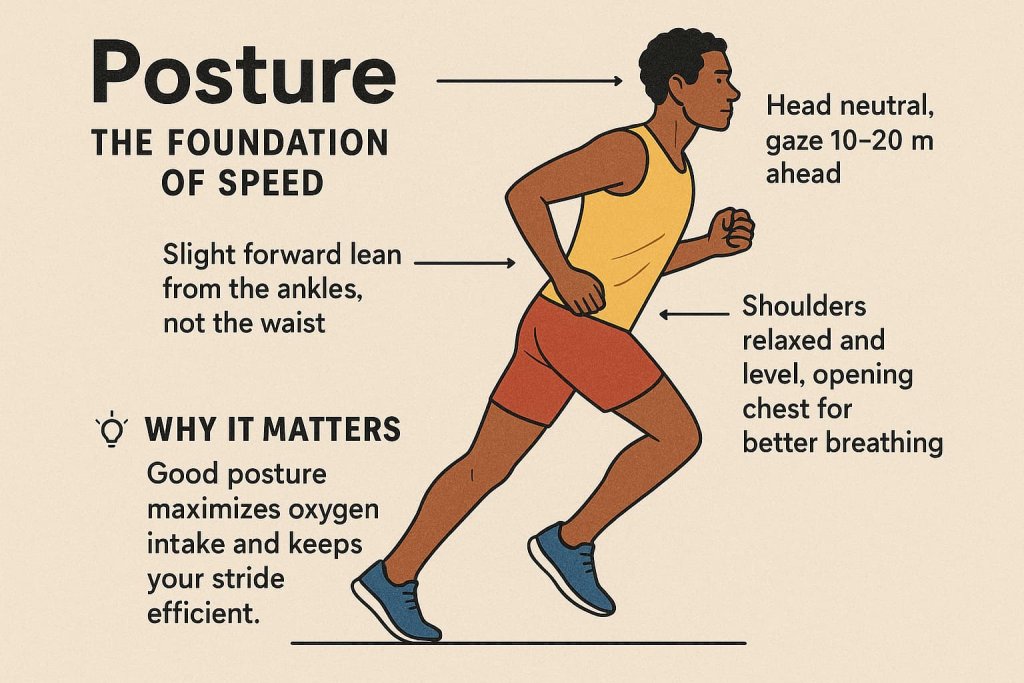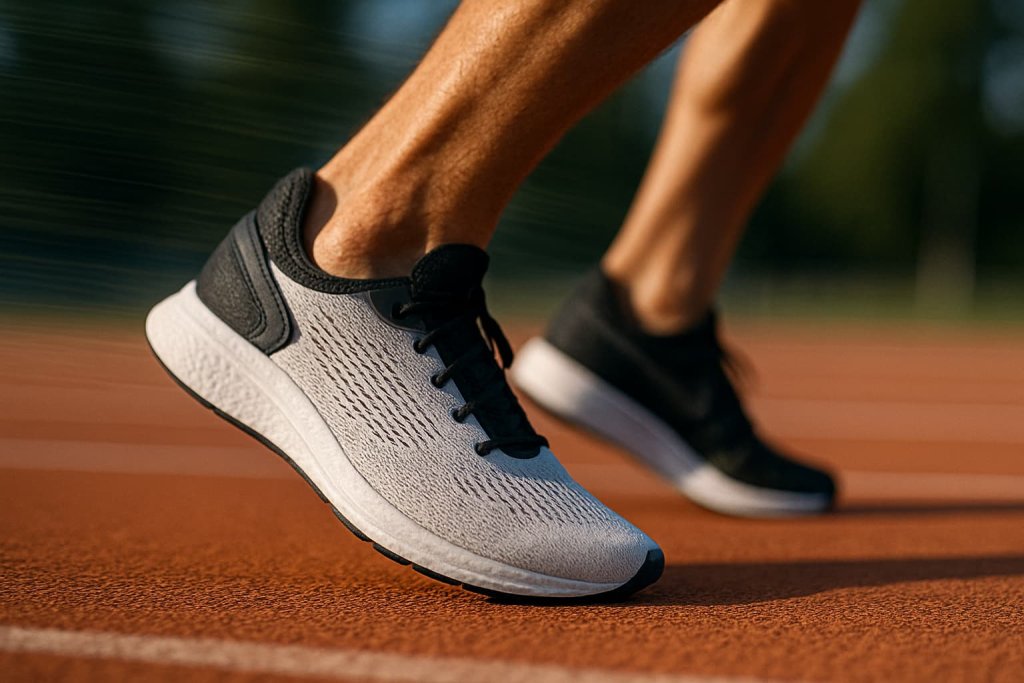Yes, you can run faster — without simply running more miles.
By improving your technique, targeting the right muscles, and training smarter, you can boost speed, efficiency, and endurance without burning out.

Understanding how to run faster isn’t just for competitive sprinters. Whether you’re chasing a personal best in a 5K, trying to finish a marathon stronger, or simply want to feel lighter on your feet, the right science-backed strategies can help you achieve measurable results in weeks.
This guide breaks down expert-approved methods including:
- Perfecting your running form to maximize efficiency.
- Incorporating speed workouts to develop fast-twitch muscle fibers.
- Building total-body strength to power each stride.
- Optimizing stride mechanics, cadence, and recovery.
📌 All backed by the latest research from sports science journals and elite coaching insights.
If you apply these strategies consistently, you’ll not only run faster but also reduce injury risk and enjoy running more. Let’s dive in.
1. Perfect Your Running Form to Improve Efficiency
Running faster isn’t just about stronger legs or bigger lungs — it’s about how efficiently you convert energy into forward motion. Your form dictates how much effort actually pushes you forward versus how much is wasted. Poor technique increases injury risk and drains energy.
📌 Science Insight: According to the Journal of Applied Physiology, optimizing running mechanics can improve running economy by up to 8%. That means you can run faster without working harder — much like upgrading your car’s engine without using more fuel.
Elite runners like Eliud Kipchoge train their form as much as they train their endurance. Why? Because even small improvements in posture, arm drive, and cadence can shave precious seconds off race times.
Core Principles of Efficient Running Form
1. Posture – The Foundation of Speed

- Slight forward lean from the ankles, not the waist.
- Head neutral, gaze 10–20 meters ahead.
- Shoulders relaxed and level, opening the chest for better breathing.
💡 Why It Matters: Good posture maximizes oxygen intake and keeps your stride efficient.
2. Core Engagement – Your Stability Anchor

- Engage deep abdominal muscles to keep hips stable.
- Imagine a string pulling your belly button slightly in and up.
- A strong core reduces side-to-side rocking and keeps energy moving forward.
📌 Pro Example: Top marathoners perform planks, side planks, and bird dogs daily to keep hips stable under fatigue.
3. Cadence – Your Speed Rhythm

- Target 170–180 steps per minute for most distances.
- Use a metronome app or running watch to track.
- Higher cadence prevents overstriding and reduces impact forces.
💡 Form Tip: If your cadence is low, increase gradually by 5% over a few weeks.
4. Arm Drive – The Upper Body Engine

- Elbows bent at ~90°, moving straight forward and back.
- Hands relaxed, as if holding a fragile potato chip.
- Avoid crossing arms over the body — this wastes momentum.
5. Foot Strike – Efficient Ground Contact

- Land midfoot directly under your hips.
- Quick, light contact — imagine the ground is hot.
- Avoid heavy heel strikes far in front of your body.
Practical Form Improvement Strategies
- Weekly Video Analysis:
- Film yourself running at race pace from the side and front.
- Compare to elite runner footage (e.g., Kipchoge, McLaughlin-Levrone).
- Work on just one form tweak per week to avoid overload.
- Pre-Run Form Drills:
- High Knees – For knee lift and quick turnover.
- Butt Kicks – For hamstring activation.
- A-Skips – For landing mechanics.
- Bounding – For hip extension power.
- Strengthen Weak Links:
- Focus on glutes, hamstrings, and core to maintain form under fatigue.
4-Week Running Form Improvement Plan
| Week | Focus Area | Daily Drill (5–10 min) | Form Check |
|---|---|---|---|
| 1 | Posture & Core | 2×30s planks, 2×10 bird dogs | Video side profile – check lean & stability |
| 2 | Cadence | 4×2 min runs at +5% current cadence | Monitor step rate |
| 3 | Arm Drive | 3×30s arm swings, 4×50m strides | Video to avoid crossing arms |
| 4 | Foot Strike | 6×20m barefoot strides on grass | Review quick, midfoot landings |
2. Incorporate Speed Workouts to Target Fast-Twitch Muscle Fibers

If you want to run faster, simply logging steady-paced miles isn’t enough. Your body adapts to repeated stress, and if that stress never changes, progress stalls.
Speed training activates your fast-twitch muscle fibers — the ones responsible for short bursts of power and quick leg turnover — while also improving your cardiovascular capacity so you can sustain faster paces for longer.
Fast-twitch fibers are especially important for sprinting, surging, and finishing strong in races. Training them not only boosts your top speed but also raises your lactate threshold, meaning you can run faster before fatigue sets in.
How Speed Work Changes Your Physiology
- Neuromuscular Adaptation: Trains your brain and muscles to fire in sync for quicker, more powerful strides.
- Cardiovascular Gains: Increases VO₂ max, the maximum oxygen your body can use during intense exercise, which is a strong predictor of endurance performance.
- Metabolic Efficiency: Teaches your body to clear lactate more effectively, delaying the burn that slows you down.
Proven Speed Workouts
1. Intervals
- Example: 8×400m at 85–90% of your maximum effort, with 90 seconds of walking or light jogging between reps.
- Why It Works: This workout pushes your aerobic and anaerobic systems, teaching your body to recover quickly between hard efforts. It’s ideal for 5K and 10K race prep.
- Beginner Tip: Start with 4–5 reps and build up as your fitness improves.
2. Hill Sprints
- Example: 8–12 seconds uphill at maximum effort, walk back down for full recovery.
- Why It Works: Running uphill naturally forces you into proper sprinting form — higher knees, strong arm drive, and shorter ground contact time. It builds explosive power in your glutes, hamstrings, and calves without the impact stress of flat sprints.
3. Strides
- Example: 6–8×20–30 seconds at ~90% of your max speed after an easy run, with 60–90 seconds rest between strides.
- Why It Works: Strides improve your running economy, coordination, and leg turnover in a low-fatigue way, making your regular training pace feel smoother.
4. Fartlek Runs
- Example: 5×2 minutes fast, followed by 2 minutes easy, or simply use landmarks (e.g., sprint to the next lamp post, jog to the next tree).
- Why It Works: The unstructured nature keeps the workout fun while improving your ability to change speeds — a crucial skill for racing and group runs.
📌 Science Insight:
A 2024 study in the European Journal of Applied Physiology found that six weeks of structured interval training improved 5K times by an average of 4% in recreational runners. This was attributed to increased VO₂ max, better lactate clearance, and improved neuromuscular coordination.
💡 Pro Tip:
Limit intense speed sessions to 1–2 per week and allow at least 48 hours between them. Always warm up with 10–15 minutes of easy running and dynamic drills before starting — cold muscles are more prone to injury.
3. Build Strength to Run Faster and Prevent Injuries

Running is a series of single-leg jumps. Strength training increases the force you can produce with each stride while improving stability and resilience.
Why Strength Training is Non-Negotiable for Runners
Strength training for runners delivers three key benefits:
- Faster Running Speeds – Stronger muscles produce more force per stride, increasing speed without increasing perceived effort.
- Better Running Economy – Less wasted energy through improved posture and stability.
- Reduced Injury Risk – Strong, resilient muscles, tendons, and ligaments are better equipped to handle repetitive impact forces.
📌 Research Insight:
A 2024 Journal of Strength and Conditioning Research meta-analysis found that recreational and elite runners who trained strength 2–3 times per week improved sprint performance by 3–5% and reduced overuse injury risk by up to 50%.
Strength Training Essentials for Runners
1. Lower Body Power
These compound lifts strengthen multiple muscle groups at once, mimicking running’s movement patterns.
- Squats (Back or Front): Build quadriceps, hamstrings, and glutes for propulsive force.
- Lunges (Walking or Reverse): Improve hip stability and stride balance.
- Deadlifts (Conventional or Romanian): Target the posterior chain, enhancing push-off strength and reducing hamstring injury risk.
💡 Pro Tip: Focus on proper form and controlled movement rather than heavy weights at first.
2. Core Stability
A strong core maintains spinal alignment and pelvic stability, keeping your form intact under fatigue.
- Planks: Strengthen the entire core while teaching bracing techniques.
- Side Planks: Target the obliques for lateral stability.
- Pallof Press or Anti-Rotation Holds: Train the core to resist unwanted twisting motions during running.
3. Plyometrics for Explosive Speed
Plyometric exercises train fast-twitch fibers and improve your body’s ability to produce force quickly — crucial for sprinting and accelerating.
- Box Jumps: Develop explosive leg power and coordination.
- Jump Lunges: Improve balance, coordination, and hip mobility.
- Bounding: Mimics running strides with exaggerated power, enhancing push-off mechanics.
📌 Training Note: Always perform plyometrics after a thorough warm-up to avoid injury.
How to Structure Strength Training with Running
- Frequency: 2–3 times per week.
- Best Days: After easy runs or on cross-training days.
- Duration: 30–45 minutes per session.
- Phases:
- Base Season: Focus on heavy compound lifts for raw strength.
- Race Prep: Shift toward explosive, lighter plyometric work.
8-Week Progressive Strength Plan for Runners
| Week | Lower Body Focus | Core Focus | Plyometric Focus | Notes |
|---|---|---|---|---|
| 1–2 | Squat 3×10, Lunge 3×12, Deadlift 3×8 | Plank 3×30s, Side Plank 3×20s/side | Box Jumps 3×8 | Start light to learn form |
| 3–4 | Squat 4×8, Walking Lunge 3×14 steps, RDL 4×10 | Pallof Press 3×12/side, Bird Dog 3×12/side | Jump Lunges 3×6/side | Add weight gradually |
| 5–6 | Front Squat 4×6, Bulgarian Split Squat 3×10/leg, Calf Raise 4×15 | Hollow Hold 3×20s, Side Plank with Leg Lift 3×8/side | Bounding 3×20m | Increase plyometric intensity |
| 7–8 | Squat 4×5, Lunge 4×8/leg, Deadlift 4×6 | Plank Shoulder Taps 3×12, Anti-Rotation Hold 3×15s/side | Single-Leg Hops 3×5/leg | Peak strength, reduce volume before races |
4. Optimize Stride Length and Cadence

Speed = Stride Length × Stride Frequency. You need both to run faster.
How to Improve
- Cadence Drills: Use a metronome app to increase steps per minute gradually.
- Bounding: Practice long, controlled strides without overstriding.
- Resisted Running: Short sprints with resistance bands or sleds to build stride power.
📌 Pro Example: Usain Bolt’s stride length is legendary — but he also maintains high turnover, a combination recreational runners can improve through drills.
5. Train Your Mind Like an Elite Athlete

Your mental approach can be the difference between maintaining speed and slowing down when fatigue hits. Elite athletes use sports psychology techniques to sharpen focus and manage effort.
Mental Strategies
- Attentional Narrowing: Focus on a specific point ahead to lower perceived effort.
- Performance Mantras: Short cues like “light and fast” or “drive the knees” keep form intact.
- Visualization: Mentally rehearse your race to improve pacing and confidence.
📌 Pro Example: Olympic champion Allyson Felix credits visualization with keeping her calm and focused under pressure.
📌 Learn more: American Psychological Association – Sports Psychology
5. Prioritize Recovery to Unlock Your Speed Potential
Speed gains happen between workouts when your muscles recover and adapt. Without recovery, you’ll risk burnout and injury.
Recovery Best Practices
- Rest Days: 1–2 weekly to allow full muscle repair.
- Sleep: 7–9 hours for optimal hormone function.
- Active Recovery: Light cycling, swimming, or yoga to improve blood flow.
- Foam Rolling & Stretching: Keeps muscles supple and reduces soreness.
📌 Science Insight: The British Journal of Sports Medicine found that athletes who skipped recovery were 30% more likely to sustain overuse injuries.
📌 More tips: Cleveland Clinic – Recovery After Exercise
6. Fuel Your Body for Peak Performance
Your body is a performance engine — without the right fuel, it won’t run at top speed.
Nutrition Guidelines
- Carbohydrates: Primary energy source for high-intensity running (rice, oats, sweet potatoes).
- Protein: 1.2–2g per kg of body weight daily to repair muscles.
- Healthy Fats: Avocado, nuts, and olive oil for hormonal balance.
- Hydration: Even a 2% drop in hydration can impair performance (NIH Study).
📌 Race-Day Tip: Eat a carb-rich meal 3–4 hours before racing — oatmeal with banana and honey is a runner favorite.
7. Progress Gradually to Avoid Overtraining
Overtraining is one of the fastest ways to stall your progress. The 10% rule — increasing volume or intensity by no more than 10% weekly — is a safe guideline.
Sample Mileage Build-Up
- Week 1: 20 miles
- Week 2: 22 miles
- Week 3: 24 miles
- Week 4: 18 miles (recovery week)
📌 Training Tip: Use periodization — alternating hard, moderate, and easy weeks — for sustainable progress.
8. Choose Gear That Supports Speed and Comfort
While training matters most, the right shoes and gear can improve efficiency and prevent injuries.
Gear Recommendations
- Lightweight Trainers: Reduce fatigue over long runs.
- Carbon-Plated Racers: Improve running economy by up to 4% (Nike Vaporfly study).
- Technical Socks: Reduce friction and wick moisture.
- GPS Watch: Tracks pace, cadence, and heart rate for smarter training.
Quick Recap Table
| Strategy | Why It Works | Example |
|---|---|---|
| Perfect Form | Improves running economy & reduces wasted energy | Cadence drills |
| Speed Workouts | Builds fast-twitch fibers & VO₂ max | 8×400m intervals |
| Strength Training | Increases power & stability | Bulgarian split squats |
| Mental Strategies | Maintains pace under fatigue | Visualization |
| Recovery | Prevents injury & supports adaptation | Foam rolling |
| Nutrition | Fuels performance & recovery | Carb-loading |
| Gradual Progression | Avoids overtraining | 10% rule |
| Gear Optimization | Improves comfort & efficiency | Carbon shoes |
FAQs
1. How quickly will I see results?
With consistent training, you may notice improvements in 4–8 weeks.
2. Should beginners do speed workouts?
Yes, but start with strides or short intervals once a week.
3. Are carbon-plated shoes worth it?
Yes for racing, but they’re not a replacement for proper training.
4. Can weight loss improve speed?
If you carry excess fat, moderate weight loss can help — but focus on strength and form first.
5. Is running every day good for speed?
Only with varied intensity and proper recovery days.
6. What’s the #1 mistake runners make when trying to get faster?
Neglecting recovery and form in favor of high mileage.
Conclusion
Running faster is not about pushing harder every day — it’s about training smart.
By perfecting your form, adding structured speed work, building strength, sharpening mental focus, fueling properly, and prioritizing recovery, you can run faster without risking burnout or injury.
Start small, track your progress, and remember: the smartest runners are often the fastest.
